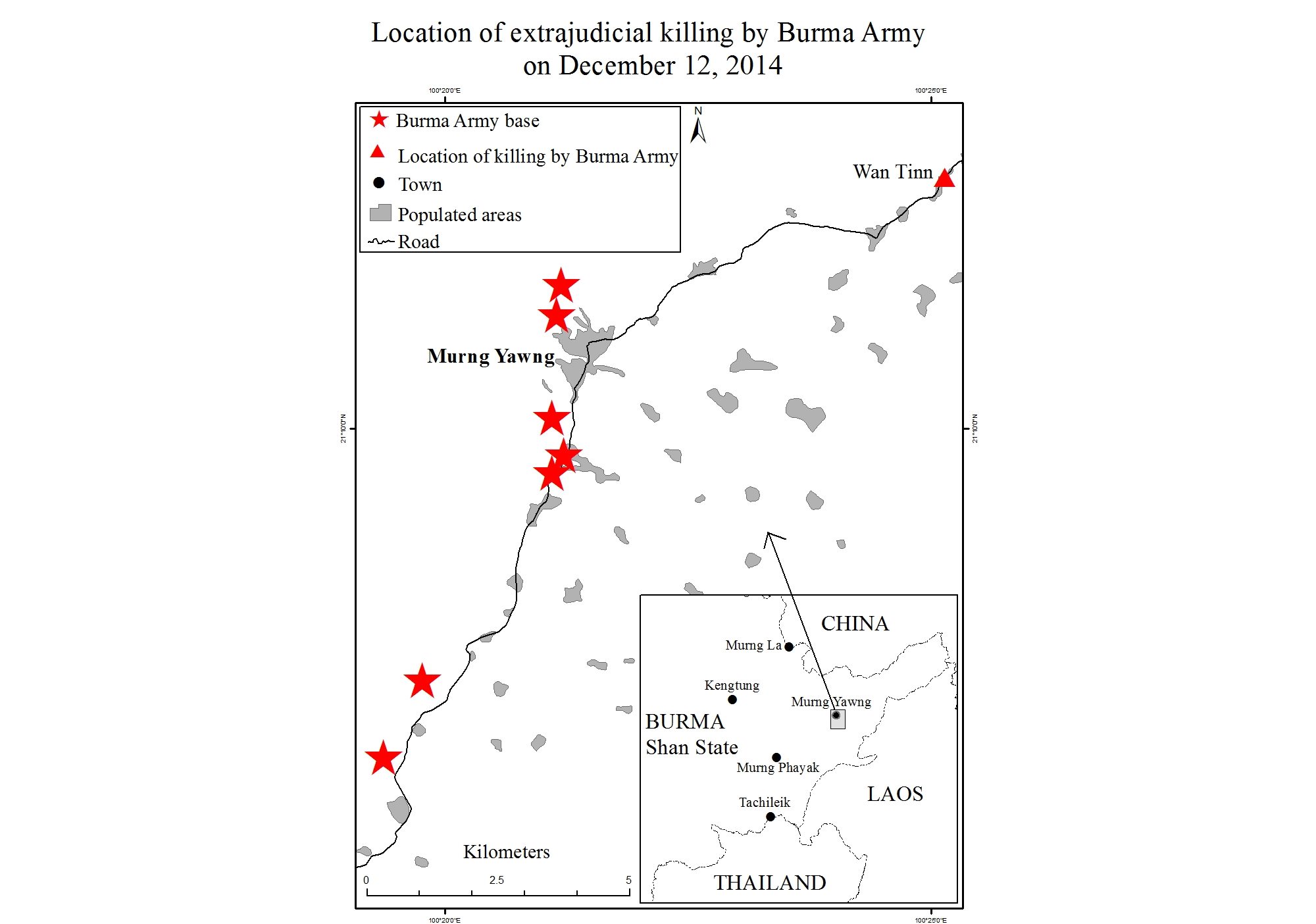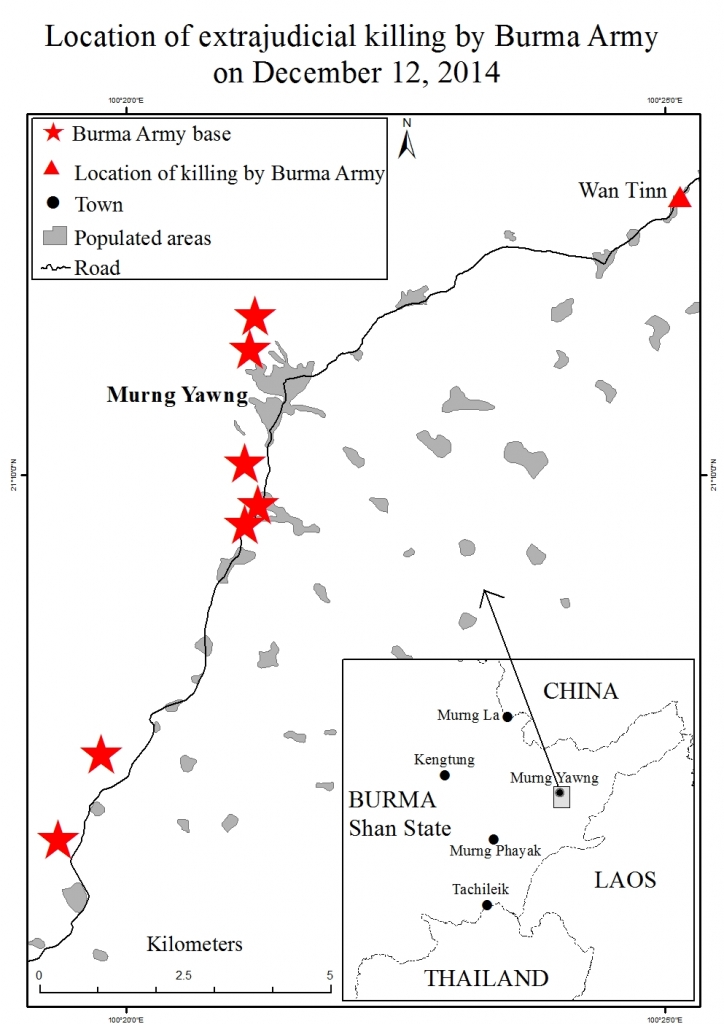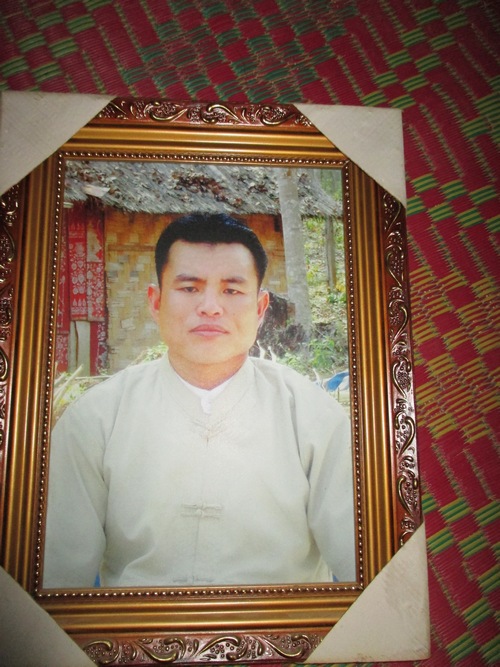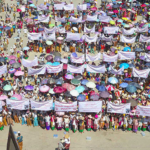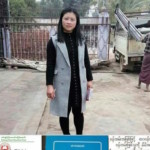Shan Human Rights Foundation, January 7, 2015
Burma Army Kill Villager in Front of His Parents, Then Force over 1,200 Villagers to Demonstrate Against “Insurgents” for Killing Civilians in Murng Yawng
On December 12, 2014, Burma Army troops from LIB 573 shot and killed a 32-year-old mentally ill villager, Sai Sarm Tip, at his house in front of his parents, in the village of Wan Tinn, in Murng Yawng, eastern Shan State. The troops had surrounded the house, ordered Sai Sarm Tip to come out, then shot him as he stepped outside.
Two days later, on December 14, over 1,200 villagers from all 66 villages in Murng Yawng township, and all nine quarters of the town, were forced by the Burma Army to join a public demonstration in the sports field in Murng Yawng town against “an insurgent group”. One person from each household was ordered to attend, and local Shan village representatives were paid 50,000 kyat each to read out prepared statements denouncing the insurgents, and blaming them for taxing and recruiting local people, and for killing innocent civilians. All the villagers were forced to shout prepared slogans in Burmese, calling for the insurgent group to be “wiped out.” The main resistance group operating in Murng Yawng is the Restoration Council of Shan State (Shan State Army-South), which has had a ceasefire with the Burmese government since December 2011.
SHRF strongly denounces the unprovoked extrajudicial killing of Sai Sarm Tip, and calls for those responsible to be held to account for this crime.
SHRF also condemns the Burmese military authorities for ordering local villagers to join a mass protest against an ethnic resistance group for crimes which they are committing themselves. Forcing villagers to do this is a violation of their rights, and an insult to their intelligence and dignity. It is also reprehensible of the Burma Army to be launching public campaigns to discredit ethnic armed groups, when the government claims to be trying to build peace in the country.
Details of the extrajudicial killing of Sai Sarm Tip on December 12, 2014
The account below was related by Sai Sarm Tip’s father Loong Nan Oon, who witnessed the killing. It should be noted that after the killing, the Burmese troops called the police from Murng Yawng to the scene of the crime, but the police did not ask Loong Nan Oon or his wife any questions at all about what had happened.
Loong Nan Oon’s account:
I am Shan (Tai Lue). I am a farmer. I live in Wan Tinn, Wan Tap tract, Murng Yawng township. My village has 13 houses and 64 people. My wife is called Ba Seng Inn. We had three children. My elder son is a monk in Sipsong Panna, China. My daughter is married and lives with her husband in another village. Our younger son, Sai Sarm Tip, lived with us. He was 32 years old. He used to be a farmer, and in 2011, he joined the Shan State Army-South for one year, and then resigned from it officially, reporting his resignation to Burma Army LIB 334 in Murng Yawng in 2012. After this, about one year ago, he became mentally ill.
Everyone in the area knew that Sai Sarm Tip was mentally ill. Local people had reported him to the police several times because they were worried he would cause violence, and he was locked up in Murng Yawng Jail for 45 days, but he had not harmed anyone. About three months ago, I bought a car, and he used to drive it around. He liked to sleep in the car, parked at our house.
On November 18, 2014, Sai Sarm Tip was sleeping in the car, parked in front of our house. He was wearing camouflaged trousers (like many civilians in the area). Some Burma Army soldiers from LIB 335 were patrolling by, and saw him, and asked him to get out of the car. He refused to get out, and drove away, so the soldiers shot at him, hitting the car with 8 bullets. The soldiers then rang their commanding officer, Khin Maung Than, who arrived at the house, with an interpreter, and I explained that Sai Sarm Tip was mentally ill, so they did not take any further action.
On December 12, 2014, at 9.30 pm, a Burma Army officer called Ye Htun Aung came with 12 other armed Burma Army soldiers from LIB 573, to check who was staying in our house. They came with a translator called Nan Moon, from our village, and with our village headman Noi Lee, and the village tract headman, Noi Ing. They asked us where our son, Sai Sarm Tip, was. When we told them that he was sleeping in his car at our house, they tried to call him from the car, but he refused to come out. The group of soldiers then went to check the inhabitants of other houses in the village.
At 10.30 pm the soldiers came back to our house and surrounded it. My wife and I were asleep. The soldiers woke us up, and asked us to turn on the lights. They called Sai Sarm Tip to get out of the car, but he refused. He said, “I didn’t do anything wrong”. I saw that the soldiers had already let the air out of the car wheels, so that he wouldn’t drive away. They were pointing their guns at him, and I was afraid they would shoot, so I called to him to get out of the car.
Sai Sarm Tip then got out of the car. He was holding in his outstretched hands a knife in a wooden sheath (which he always carried with him), and a small homemade shotgun. The gun was laid on the sheathed knife, and was not being aimed at anyone. He walked into the house, and went into his room. He walked directly past the Burma Army officer, only about one foot away; the officer leaned away as he passed, but it was clear that Sai Sarm Tip was not trying to hurt anyone. All the soldiers, except the officer, had their guns pointed at him.
Sai Sarm Tip went into his room and shut his door. He stayed there for about 10 minutes. The officer called him to come out. I also called out to him: “Come out. If you don’t, they will shoot you in our house. Come and talk to the officer.”
Finally, Sai Sarm Tip came out of his room, holding the sheathed knife and gun as before in his outstretched hands, and went down the steps of the house. He had just put on one of his sandals, when the soldiers starting shooting at him. Two soldiers shot him, with four bullets. They were standing at the outside entrance to the house, with the other soldiers and the officer behind them. I was also standing there, with my wife, behind the soldiers. There was no order to fire. They just fired as he came out of the house.
As soon as he was shot, he cried out, and I rushed to hold him. He passed away in my arms after about 2 minutes. I called out: “My son’s dead. Stop shooting!” Then I laid him down on the ground.
The soldiers came to check if he had died or not. I saw only two bullet wounds, one on his arm, and one in his groin. A soldier pulled up his shirt, and I saw the wound in the groin, but there must have been other wounds. There was a lot of blood flowing from his body.
Sai Sarm Tip was wearing camouflaged pants when he went into his room, but when he came out he was wearing black trousers. The soldiers asked me: “Where is his army shirt?” I said I didn’t know. One soldier said he had seen it in the car. There was a camouflaged shirt in the car, and they went to get it, as well as another knife which he kept in the car. They told me to go and get his camouflaged trousers. They folded up the camouflaged clothes, and took Sai Sarm Tip’s three knives (including the one he kept in a sheath at his waist too), and his shotgun, and put them on a table, and took photos with their mobile phones.
The officer phoned to the local Burma Army commander, Khin Maung Than. He came at about 11 pm in an army truck, with about 3-4 soldiers, and took photos, then he called the police. Two policemen came after 30 minutes, and then called some doctors from Murng Yawng. The police checked the body of Sai Sarm Tip, and didn’t ask me anything about how he was killed. It was about an hour before two doctors arrived. They put on gloves and checked the body. I didn’t see what they were checking, because I wasn’t allowed to stand close. The doctors didn’t ask me anything about the killing either.
Then I asked the police, “Are you finished with my son? Can I cremate him now?”
The police said: “Yes, you can cremate him now.”
After the doctors, the police and the commander left, the soldiers went to the temple in Wan Tinn, where they stayed three nights.
After all the soldiers had left my house, the tract headman called all the other villagers from Wan Tinn. Our “Bu Jan” (the villager responsible for presiding over ceremonies) said we had to cremate the body straight away, because he had died abnormally, and, according to local belief, it would bring bad luck if we did not do so. My brother-in-law rode a motorbike to another village, and called some villagers from there to come and prepare the cremation, because the villagers in our village were too afraid to do so. I paid four people from the other village 30,000 kyat each to use white cloth and a mat to wrap up the body, and take it with two tolagyi (small tractors, which I rented for 20,000 kyat each) to the local cemetery, and carry firewood for the cremation. I had to pay 30,000 kyat for firewood.
We held the cremation at 4 am on December 13. About 20 people attended the ceremony. The “Bu Jan” said prayers at the ceremony.
The “Bu Jan” then went to the temple, and the monk said we had to dig up the ground where my son’s blood had spilled, and burn it together with the body, to get rid of bad luck. So the 4 people I had hired also dug up the area where Sai Sarm Tip had died, and brought the ground to be burned at the cremation area, which was still smouldering. Seven days later (according to local custom), I laid new cement to fill the hole at the house.
On December 13, at 9 am the police and Sai Htay (who I had bought the car from) came together to my house, and the police told me they would take away the car, according to the law. I had to sign a piece of paper, also signed by our headman, stating that the police would take the car temporarily.
For further information, contact
Sai Hor Hseng 66: (0) 93-264-9487 (Shan, English)
Nang Kwarn Lake 66: (0) 84-668-0984 (Burmese, English)
Download statement (PDF): English | Burmese | Shan

